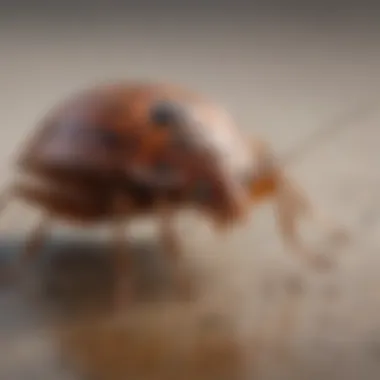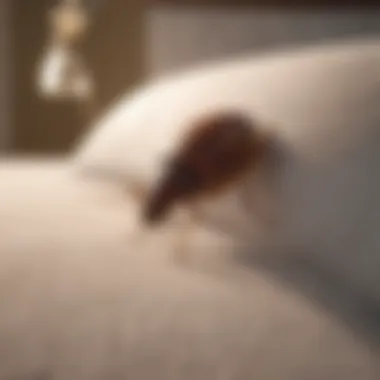Understanding Bed Bug Patrol Spray: An Essential Guide


Intro
Bed bug infestations present a significant concern for many homeowners. Not only do these pests disrupt your sleep, but they also pose health risks through bites and allergic reactions. Understanding the methods available to control and eliminate bed bugs is crucial. One of the most effective solutions on the market today is bed bug patrol spray. This guide delves into the essential aspects of bed bug patrol spray, including its formulations, application methods, and effectiveness in pest control.
Pest Identification
Before addressing a bed bug infestation, it is important to identify the pest correctly. Misidentifying the pest can lead to mismanagement and ineffective treatments.
Common Household Pests
Among the various types of pests that can invade a home, bed bugs are particularly notorious. They are tiny, brownish insects that feed on human blood. Unlike other pests, bed bugs do not fly. Their small size and ability to hide in cracks and crevices make them hard to detect until an infestation is well established. Other common pests might include ants, cockroaches, and termites, but they require different approaches for eradication.
Signs of Infestation
Signs of a bed bug infestation include:
- Bites: Small, red, itchy welts on the skin.
- Fecal spots: Dark spots on bedding or furniture, indicating the presence of droppings.
- Shed skins: As bed bugs grow, they shed their outer skin, which may be found in their hiding spots.
- Unpleasant odor: A musty smell may arise from a large infestation, caused by pheromones from the bugs.
Recognizing these signs early allows for more effective treatment.
Prevention Methods
Prevention remains a key strategy in managing bed bug issues. By taking proactive measures, homeowners can significantly reduce the risk of infestations.
Environmental Modifications
Modifying the environment can make a significant difference. Keeping the home tidy and clutter-free makes it easier to spot any signs of bed bugs before they proliferate. Here are simple modifications you may consider:
- Vacuum regularly, especially in areas like carpets and behind furniture.
- Use protective covers on mattresses and pillows to create a barrier against bed bugs.
Home Maintenance Tips
Maintaining your home is important in preventing bed bugs. Simple maintenance tasks include:
- Seal cracks and crevices in walls and furniture to eliminate hiding spots.
- Be cautious when bringing second-hand furniture into your home.
- Check for signs of infestation when traveling or using shared accommodations.
DIY Pest Control Solutions
For some, hiring professional pest control may not be an immediate option. Therefore, DIY solutions can be an alternative.
Natural Remedies
Some natural remedies claimed to repel or eliminate bed bugs include:
- Diatomaceous earth: This powder causes dehydration in bed bugs when they come in contact with it.
- Essential oils: Certain oils like tea tree oil and lavender are said to repel bugs, although scientific backing may be limited.
DIY Traps and Barriers
Creating traps or barriers can also be an effective measure. You could use:
- Double-sided tape around bed legs to trap bed bugs as they climb.
- Sticky traps to monitor bed bug activity in bedrooms and living areas.
"Understanding bed bug behavior and their life cycle is essential in both prevention and treatment strategies."
Culmination
This guide has outlined the essential components related to understanding bed bug patrol spray and controlling infestations. Effective management relies not only on identifying pests but also on prevention methods and possible DIY traps. The significance of being informed about your options cannot be overstated. By integrating various strategies, homeowners can work towards a pest-free environment.
Prologue to Bed Bugs
Bed bugs have become a significant concern for homeowners and renters alike. Their resurgence in various environments, including hotels and homes, has increased the need for understanding these pests. This section serves as a foundation for the discussion about Bed Bug Patrol Spray, emphasizing the necessity of recognizing and addressing bed bug issues effectively.
The importance of learning about bed bugs cannot be overstated. They are not merely an inconvenience; they can cause physical discomfort, financial strain, and psychological distress. Infestations can happen to anyone, regardless of cleanliness or socioeconomic status. Thus, awareness and knowledge are vital in combating these pests.
Identifying Bed Bugs
Identifying bed bugs early can prevent a small problem from becoming a serious infestation. Adult bed bugs are approximately the size of an apple seed, with flattened bodies that can swell after a blood meal. Their color varies from light brown to reddish-brown. These insects often hide in dark, secluded corners, which makes them challenging to spot.
Signs of bed bugs include:


- Tiny dark spots on sheets or mattress seams, indicating fecal matter.
- Shed skins near hiding spots, showing where they have molted.
- A musty odor in heavily infested areas, caused by pheromones.
Using a flashlight and a magnifying glass can be helpful for thorough inspections. It is recommended to also check luggage after traveling.
Understanding Bed Bug Behavior
Bed bugs are nocturnal creatures, meaning they are most active at night. Understanding their behavior is crucial for effective pest control. They are drawn to warmth and carbon dioxide—emitted by sleeping humans—making them likely to bite during the night. A typical feeding session lasts about 5 to 10 minutes.
Additionally, bed bugs can survive for several months without feeding, complicating eradication efforts. Their resilience requires a multifaceted approach to treatment.
Successful pest control begins with a deep understanding of the insect’s habits and habitats.
Ultimately, knowledge about bed bugs empowers homeowners to act swiftly and effectively, thus protecting their living spaces and well-being. As we move on, the discussion will include how Bed Bug Patrol Spray can play a vital role in eliminating these pests.
The Impact of Bed Bug Infestations
Bed bug infestations present significant challenges and consequences for those affected. Understanding the impact of these pests goes beyond simple annoyance; it includes serious health risks and psychological stresses. As these bugs become increasingly resistant to treatments, it is crucial to grasp their influence on households and the necessary responses required for effective control. Knowing the consequences of infestations can shape how one approaches pest management, ultimately aiding in the prevention of extensive damage to both health and well-being.
Health Risks Associated with Bed Bugs
Bed bugs are primarily known for their ability to cause discomfort through biting. Their bites can lead to itchy welts and skin inflammation, disrupting sleep and daily life. However, the health risks go beyond the immediate physical sensations. In certain situations, individuals may develop allergic reactions to bed bug bites, which can cause severe itching or even secondary skin infections from scratching. While bed bugs are not known to transmit diseases directly, their presence can prompt anxiety and stress, which can further exacerbate health conditions.
Additionally, the emotional and psychological toll can also manifest as insomnia or increased anxiety. Housing affected by infestations can suffer in value, as well, impacting both the owner’s peace of mind and financial standing. These factors contribute to an environment where vigilance and proactive measures become imperative.
Psychological Effects of Infestations
The psychological impact of bed bug infestations often receives less focus, yet it is equally critical. Experiencing an infestation can lead to significant stress and feelings of helplessness. Victims may develop a constant fear of being bitten, which can create a cycle of anxiety that disrupts daily life. The stigma surrounding bed bugs can also exacerbate feelings of embarrassment, leading to social withdrawal.
Studies indicate that individuals dealing with bed bugs are at a higher risk for anxiety, depression, and even post-traumatic stress disorder. The persistent worry about bringing these pests into other environments may cause anxiety to seep into various aspects of their lives. Therefore, recognizing and addressing these psychological effects is essential in treatment and recovery.
In summary, the impact of bed bug infestations is profound and multifaceted. Awareness of these implications shapes understanding and responses to these pervasive pests. Implementing effective pest control measures not only targets the bugs but also aids in alleviating the associated health and emotional distress. This awareness is crucial for homeowners and pest control professionals as they navigate the complexities of bed bug management.
What is Bed Bug Patrol Spray?
Bed Bug Patrol Spray is a specialized insect repellent designed to combat bed bug infestations. Understanding this product is vital for homeowners and pest control professionals aiming to effectively address bed bug issues. This section explores the formulation, application techniques, and broader implications of using such sprays in pest control.
Composition and Ingredients
The effectiveness of Bed Bug Patrol Spray largely depends on its composition. The spray typically contains a blend of active ingredients that target both the adult bed bugs and their eggs. Common ingredients include pyrethrins, which are derived from chrysanthemum flowers, and non-toxic plant oils that disrupt the bed bugs' nervous system.
Additionally, many sprays are formulated with water, emulsifiers, and surfactants to enhance application and adherence to surfaces. By selecting a spray with high-quality components, users can maximize their chances of eradicating bed bugs. The proper balance of these ingredients ensures that the spray is not only effective but also safe for residential use.
Types of Bed Bug Patrol Sprays
Bed Bug Patrol Sprays can be categorized into two main types: Chemical Sprays and Natural Sprays, each serving specific preferences and needs.
Chemical Sprays
Chemical Sprays are often chosen for their potent efficacy against bed bugs. The key characteristic of these products is their ability to provide quick results, often killing bed bugs on contact. These sprays commonly include pesticides that can penetrate the bed bug's exoskeleton, leading to rapid dehydration and death.
This makes Chemical Sprays a popular choice for immediate infestations. However, they may pose certain risks. For instance, prolonged exposure can lead to health concerns for humans and pets. Furthermore, some bed bugs may develop resistance to the active ingredients over time. Therefore, it is crucial for users to follow application instructions carefully and consider integrating these sprays into a broader pest management strategy.
Natural Sprays
Natural Sprays are gaining traction due to their eco-friendly formulation. The main advantage of these sprays lies in their derived ingredients from plants and essential oils. For example, components like tea tree oil and lavender oil are well-regarded for their bed bug repellent properties and low toxicity levels.
This characteristic makes Natural Sprays appealing to environmentally-conscious homeowners. However, they may require more frequent application since they often do not have the immediate impact that Chemical Sprays do. Their effectiveness can also vary depending on the infestation severity. Therefore, while Natural Sprays offer a safer alternative, users should be prepared for a more gradual approach to bed bug control.
By understanding these two types of Bed Bug Patrol Sprays, homeowners are better equipped to make informed decisions suited to their needs, balancing efficacy and safety.
Application Techniques
Application techniques are crucial when it comes to the effectiveness of Bed Bug Patrol Spray. Proper application not only maximizes the product's efficacy but also ensures safety for humans and pets. Understanding how to prepare for application and execute it correctly can make a significant difference in the outcome of your pest control efforts. Effective application techniques lead to thorough coverage of infested areas, thereby increasing the likelihood of eliminating bed bugs efficiently.
Preparing for Application
Preparation is essential before applying Bed Bug Patrol Spray. Here are some steps to consider:
- Identify Infested Areas: Before beginning, ascertain where the bed bugs are located. This could be on mattresses, box springs, or in hidden crevices.
- Vacuum Thoroughly: A thorough vacuuming of affected areas can remove some bed bugs and their eggs. Dispose of the vacuum bag immediately to prevent any escaping insects.
- Clear the Area: Remove personal belongings, such as clothing and bedding, from the vicinity. This prevents any obstruction during spraying and reduces contamination of your items.
- Read Instructions: Each product may have specific instructions and precautions. Read the label carefully to understand the recommended methods and safety guidelines.
- Wear Protective Gear: Consider using gloves and a mask during application to minimize exposure to chemicals, especially for chemical sprays.
Step-by-Step Application Process


A structured approach helps ensure effective application. Follow these steps:
- Shake the Spray Well: If using a bottled spray, shake well before applying. This ensures that the solution is mixed thoroughly for maximum effectiveness.
- Test a Small Area: Before widespread application, test the spray on a small, inconspicuous area. This helps to check for any adverse reactions to your surfaces.
- Hold the Spray at Distance: Aim to hold the spray nozzle approximately 8 to 12 inches away from the surface being treated. This distance helps to ensure even distribution.
- Apply in a Targeted Manner: Focus on key areas such as seams of mattresses, corners, and furniture edges. Spray until slightly damp but avoid soaking the surfaces.
- Leave Treated Areas to Dry: Allow the sprayed areas to dry completely before contacting them. This extends the exposure time to the bed bugs, enhancing the product's effectiveness.
- Repeat as Necessary: Depending on infestation levels, multiple applications might be required. Always adhere to the manufacturer’s guidelines regarding frequency of reapplication.
"Proper application techniques can significantly affect the success of Bed Bug Patrol Spray."
Following these preparation and application steps ensures you are well-equipped to handle bed bug infestations effectively.
Effectiveness of Bed Bug Patrol Spray
Understanding the effectiveness of Bed Bug Patrol Spray is vital for anyone dealing with bed bug infestations. It helps in evaluating whether the product is worth the investment. Moreover, knowing its efficiency can guide homeowners and pest management professionals in their eradication efforts.
Efficacy Testing Results
Efficacy testing is a key aspect of any pest control product. Various studies have shown that Bed Bug Patrol Spray can significantly reduce bed bug populations. In controlled environments, products are compared against a control group to assess the reduction in bed bug activity. These results should be transparent and accessible to consumers for informed decision-making.
Testing often involves measuring the residual effectiveness of the spray on various surfaces as well as its immediate knockdown efficacy. The sooner the spray works, the more it can help in areas with heavy infestations.
Some studies report a 90% reduction in bed bugs within a specified time frame after application. However, these outcomes can vary based on factors such as application methods and environmental conditions.
Factors Influencing Effectiveness
Environmental Conditions
Environmental conditions play a crucial role in the effectiveness of Bed Bug Patrol Spray. Temperature and humidity levels directly impact how well the spray performs. For instance, warmer temperatures can enhance the activity of bed bugs, making control efforts more necessary.
Sprays may not work as effectively in damp environments, where moisture can dilute the active ingredients. Therefore, understanding the local climate may assist in choosing the right time to apply the spray. This consideration is beneficial for homeowners to ensure better extermination outcomes.
In addition, high humidity might affect how long the product remains active after application. If conditions are favorable for bed bugs, their survival rate post-treatment increases, compromising effectiveness.
Resistance Issues
Resistance issues are another factor that can limit the effectiveness of Bed Bug Patrol Spray. Over time, bed bugs may develop resistance to specific active ingredients found in common pest control products. This growing resistance can sometimes lead to inadequate responses to treatments, forcing homeowners to seek alternative methods.
One key characteristic of resistance is the genetic adaptation of bed bugs. This results from repeated exposure to the same chemical agents, leading them to survive and reproduce despite treatment. Consequently, awareness of local resistance patterns becomes crucial in an integrated approach to pest management.
Adjusting treatment strategies, such as rotating different sprays or combining chemical and non-chemical options, might prove necessary. This adaptability can enhance the longevity and effectiveness of bed bug control efforts.
"Managing bed bug infestations requires understanding not just the product used, but also the conditions and context of its application."
Effective pest control is not solely the responsibility of a single product; it is about integrating multiple strategies and being observant. This perspective empowers both homeowners and professionals in combating bed bug infestations more effectively.
Safety Considerations
The significance of safety considerations in dealing with bed bug patrol spray cannot be overstated. Proper attention to safety ensures that not only is the spray effective, but it also minimizes risk to humans and pets. Understanding the potential health hazards and methods of handling these products can aid homeowners in creating a safe environment during pest control activities.
Health Risks for Humans and Pets
Bed bug patrol sprays, while effective, can present several health risks. For humans, common symptoms of exposure can include skin irritation, respiratory issues, nausea, and allergic reactions. These effects may vary depending on the level of exposure and the individual’s sensitivity to certain ingredients found in the sprays.
For pets, similar risks exist. Some of the chemicals used in bed bug patrol sprays may be harmful to animals. Dogs and cats are particularly vulnerable, as their smaller size can lead to a greater concentration of chemicals in their systems. It is crucial for pet owners to read the labels carefully and adhere to usage instructions to prevent accidental poisoning.
Here are a few points for consideration when using these sprays:
- Always keep pets away from treated areas until it is safe to return.
- Verify that the product is labeled as safe for home use with pets.
- Monitor pets closely for any signs of adverse reactions after exposure.
It is a wise practice to consult a veterinarian if any health concerns arise concerning your pets.
"The consequences of improper handling of pest control products can be severe, impacting not just the household but also the well-being of family members and pets."
Proper Handling and Storage
The handling and storage of bed bug patrol sprays are critical in minimizing health risks and ensuring effectiveness. Here are some important guidelines to consider:
- Read Product Labels: Always start by thoroughly reading the label and safety data sheets provided by the manufacturer. These documents supply vital information on how to use the product safely.
- Use Protective Gear: When applying sprays, consider wearing gloves and a mask. This prevents direct exposure to harmful chemicals.
- Ventilate the Area: Before and after application, ensure that the area is well-ventilated. This helps to disperse any residual chemicals that may linger in the air.
- Store Safely: Store bed bug patrol sprays in a cool, dry place away from the reach of children and pets. Keeping them in their original containers and tightly closed will prevent accidental spills and exposures.
- Disposal: Follow local regulations for disposing of unused product and containers. Improper disposal can pose risks to humans and the environment.
Sustainable Practices in Pest Control
Sustainable practices in pest control have become increasingly significant in today’s world. With rising concerns around chemical exposure and environmental health, more homeowners are seeking methods that reduce harm to both people and the ecosystem. The integration of sustainable pest management, particularly with products like Bed Bug Patrol Spray, emphasizes eco-friendliness while ensuring effectiveness against infestations.
Benefits of Sustainable Practices
Adopting sustainable pest control strategies can lead to various advantages:


- Reduced Chemical Use: Many traditional pest control methods rely on potent chemicals that can contaminate air and water sources. Sustainable methods often employ lower toxicity alternatives or even natural solutions, providing a safer environment.
- Preservation of Biodiversity: Sustainable practices take into account not just the elimination of pests but also the survival of beneficial insects and the surrounding flora. A careful approach minimizes the risk of harming important pollinators like bees.
- Long-Term Effectiveness: A comprehensive sustainable plan, including integrated pest management (IPM), can prevent future infestations by addressing the underlying causes rather than simply treating symptoms.
Considerations for Homeowners
When implementing sustainable pest control solutions, homeowners must consider several factors:
- Local Regulations: Understanding local laws regarding pesticide use is crucial. Many areas have specific guidelines promoting organic approaches or restricting certain chemicals.
- Chemical Resistance: Pests can develop resistance to traditional treatments. Shifting to sustainable methods may prevent this problem by rotating types of interventions used.
- Education and Awareness: Being informed about the options available obliges homeowners to make smarter choices. Understanding labels and composition of products like Bed Bug Patrol Spray enables more conscientious use.
"Employing sustainable practices is not just a matter of choice; it is a commitment to a healthier home and a healthier planet."
By aligning pest management strategies with sustainable principles, homeowners can contribute to ecological balance while effectively controlling bed bug populations.
Eco-Friendly Alternatives to Sprays
Eco-friendly alternatives to traditional sprays are becoming prevalent in the market. Many of these solutions rely on natural ingredients that are less harmful to humans and pets. Examples include:
- Diatomaceous Earth: A fine powder that disrupts the exoskeleton of bed bugs, leading to dehydration.
- Essential Oils: Oils like tea tree, lavender, and peppermint have repellent properties and can deter bed bugs when used properly.
- Soap Solutions: Mild soap solutions can immobilize insects, helping to manage populations without harsh chemicals.
Utilizing these alternatives allows homeowners to take proactive steps against infestations while caring for their family's health and the environment.
Integrated Pest Management Approaches
Integrated Pest Management (IPM) is a holistic approach to pest control that combines various techniques for more effective outcomes. Key components of IPM include:
- Monitoring: Regular inspections can identify early signs of infestations, allowing for timely intervention.
- Prevention: Seal entry points and maintain cleanliness to deter bed bugs.
- Control: Use a combination of methods including eco-friendly sprays, traps, and professional services when necessary.
- Evaluation: Continuously assess the effectiveness of treatment methods, adapting strategies as needed.
By employing IPM strategies, homeowners can cultivate a proactive mindset towards bed bug control, ensuring that actions taken today will benefit the home’s environment tomorrow.
Comparative Analysis with Other Treatments
In the realm of pest control, particularly in addressing bed bug infestations, understanding the comparative analysis with other treatments is essential. This section provides a detailed examination of the various methods available for combating these pests. By looking at different treatment options, homeowners can make informed decisions that align with their specific situations and preferences.
Chemical vs. Natural Treatments
Chemical treatments have long been the cornerstone of pest control. They often offer rapid results in eliminating bed bugs. Traditional products like those containing pyrethroids or neonicotinoids are widely used due to their efficacy. However, their effectiveness can vary based on several factors, including the strain of bed bugs and environmental conditions.
On the other hand, natural treatments are gaining traction. Products such as diatomaceous earth and essential oil sprays provide alternatives for those concerned about the chemicals in conventional pest control products. While they may take longer to produce results, natural solutions typically pose less risk to human health and the environment. Here are some benefits and considerations:
- Chemical Treatments:
- Natural Treatments:
- Fast action against bed bugs
- Fewer applications required
- Potential chemical resistance in bed bug populations
- Eco-friendly options available
- Generally safer for homes with kids and pets
- May require multiple applications for effectiveness
Given these insights, it is clear that choosing between chemical and natural treatments largely depends on individual priorities regarding safety, speed of action, and environmental impact.
Professional Pest Control vs. DIY Methods
When dealing with bed bugs, one of the pivotal decisions is whether to engage professional pest control services or to attempt a DIY approach. Professional exterminators bring expertise and access to products that might not be available to the average consumer. They can conduct thorough inspections and provide targeted treatments that are often more effective than over-the-counter solutions. The pros and cons of each option include:
- Professional Pest Control:
- DIY Methods:
- Extensive knowledge of bed bug behavior and life cycles
- Use of potent treatments and techniques
- Can be costly, impacting household budgets
- Cost-effective
- Greater control over the treatment process
- Requires time, commitment, and thoroughness for success
While DIY methods can be helpful, they often lack the scientific approach and experience that professionals provide. Homeowners should weigh these factors carefully to determine the best course of action.
"An informed choice between professional services and DIY methods can significantly impact the effectiveness of treatment against bed bugs."
This comparative analysis enriches our understanding of bed bug control methods, ultimately aiding in effective decision-making.
Finale
In this article, we thoroughly examined the vital aspects of Bed Bug Patrol Spray, addressing its composition, application methods, and effectiveness. Understanding the nuances of this topic is crucial for homeowners, particularly in ensuring effective treatment against the ever-problematic bed bug infestations.
Recap of Key Points
To summarize the primary points:
- Bed bug patrol sprays are formulated with various active ingredients, either chemical or natural, suited for different user needs.
- Proper application techniques are essential to maximize effectiveness and reduce risks to humans and pets.
- Understanding the environmental factors that affect the efficacy of the spray can lead to better outcomes in pest control.
- Safety considerations remain paramount, particularly regarding the health of both humans and pets during the application process.
- Sustainable practices are emerging, with eco-friendly alternatives and integrated pest management approaches gaining traction.
This comprehensive understanding equips readers with the knowledge necessary to tackle bed bug issues more efficiently. By being informed, homeowners can implement measures that mitigate infestations.
Future Directions in Bed Bug Control
Looking ahead, the fight against bed bug infestations could shift trajectory as research continues to unveil more effective solutions.
- Advances in Formulations: Ongoing development in creating less toxic and more environmentally friendly sprays may soon dominate the market. This could lead to products that are both effective and minimized health risks.
- Integrated Accuracy: The concept of integrated pest management will likely advance, combining technological tools with traditional methods for a more holistic approach. Manufactured sprays may be part of a broader strategy that emphasizes surveillance and monitoring.
- Informed Consumer Choices: An educated consumer base will increasingly favor products that prioritize sustainability. This trend may push manufacturers to innovate further, prioritizing both efficacy and ecological responsibility.
In sum, the future of bed bug control appears promising as we embrace scientific advancements and sustainable practices. Homeowners and pest management professionals alike must remain vigilant and adaptive to new information and methodologies.















